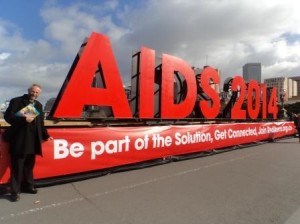The International AIDS Conference comes around every two years.This time it is in Melbourne, Australia. As with every conference there will be many things which are the same or similar to previous conferences, but there are always distinct differences as well. Melbourne is already making its mark, and this mark started before this conference already kicked off.
For months there has been significant communication amongst people working in the field of HIV. Visa requirements for Australia have been prohibitive! One of the questions asked of people applying for an Australian visa is “Have you ever had contact with a person who has TB?”. Now there is not a person living in Africa who can truthfully answer NO. We have all engaged with people who have TB, knowingly and unknowingly. Many times the person who we unknowingly engage with who has TB does not even know themselves. But for any person who answered YES to this question there was a demand of X-rays and blood tests, all of which will cost people who are already in a resource poor environment between SEK3000 and SEK 5000. Not surprisingly, many people who had jumped through these impossible hoops were still refused visas. Fortunately a strong network of NGO’s, faith communities and UNAIDS worked together to lobby with the Australian authorities to change many of these decisions. There were some victories, but my no means for all the people concerned.
This in itself raises the question of access, and of resource poor settings, and of barriers to entry. The GIPA (Greater Involvement of People living with HIV and AIDS) principle was first formulated in the 1994 Paris AIDS Summit. A key aspect of every AIDS conference is to hear the voices of people living with HIV as to their current understandings and current barriers to prevention, treatment, care and support. To have many of those voices denied access to the IAC it both tragic and outrageous.
The second event which has already created a huge impact on this conference is the horrific shooting down of flight MH17 has left a massive gap in this conference. Every time you meet a colleague in the corridor you grab them and say “Thank God you are alive”. Many key activists who had dedicated their lives to ensuring access to treatment for the most marginalized communities died on their way to Melbourne. This in and of itself reminds us yet again that day by day, year by year, the cost of lives lost because of inadequate responses to HIV is both continuous and unacceptable. At a time where medically we know more about HIV than ever before, a time when correct and available medical interventions means that people living with HIV should be able to live a normal life expectancy, across the globe there are still people standing in endless queues to receive medication which is destroying their lives, in quantities that are insufficient and at a costs which are immoral.
Through the years in the response to HIV, any different targets have been set. The first “impossible” task was set in 2003 – 3 by 5. This called for three million people to be put on treatment by 2005. While we failed in achieving this target, the drive towards it ensured that for the first time people in developing countries were being put on treatment, and by the end of 2005 we had moved from 100 000 people to more than 1.7 million people who were now accessing life saving, live changing antiretroviral therapy. Previously this had been considered impossible. The millennium development goals further highlighted keys areas of engagement that were needed to ensure universal access to prevention, treatment, care and support for all who lived with or were vulnerable to HIV.
The last number of years have put a far stronger emphasis on “no one should be left behind”. This has meant a new focus on hard to reach populations and in particular looking at five groups who have previously had very little visibility in the growing HIV response. These are people who use drugs, sex workers, prison populations, migrants and MSM (Men who have sex with men). Just to illustrate who marginalized these groups still are, current figures indicate that of HIV positive people who use drugs only 4% are accessing treatment. This gap expresses itself in the reality that there is an explosion of HIV amongst people who use drugs particularly in countries like Russia and the Ukraine. Equally the battery of homophobic legislation which criminalizes consensual loving relationships between people of the same gender has created the vulnerability that sees 44% of all new infections in Asia amongst MSM.
Today, whether we are talking about the post 2015 agenda, or ending AIDS by 2030, one thing is clear, medically it is possible, but unless we acknowledge and address the barriers to services for all people living with HIV the target of ending AIDS in our lifetime will be missed. We have 16 years, 16 years which need to be carefully planned, plotted and coordinated to ensure addressing criminalization, other legal barriers, funding discrepancies, inaction, misaction, apathy and access to prevention treatment, care and support. As faith based organizations and communities this is not a time to reduce our response, but rather to systematically and effectively scale up our response to achieve what we thought was unachievable. “It is foolish to reduce the heat before the water boils”.

Lämna ett svar